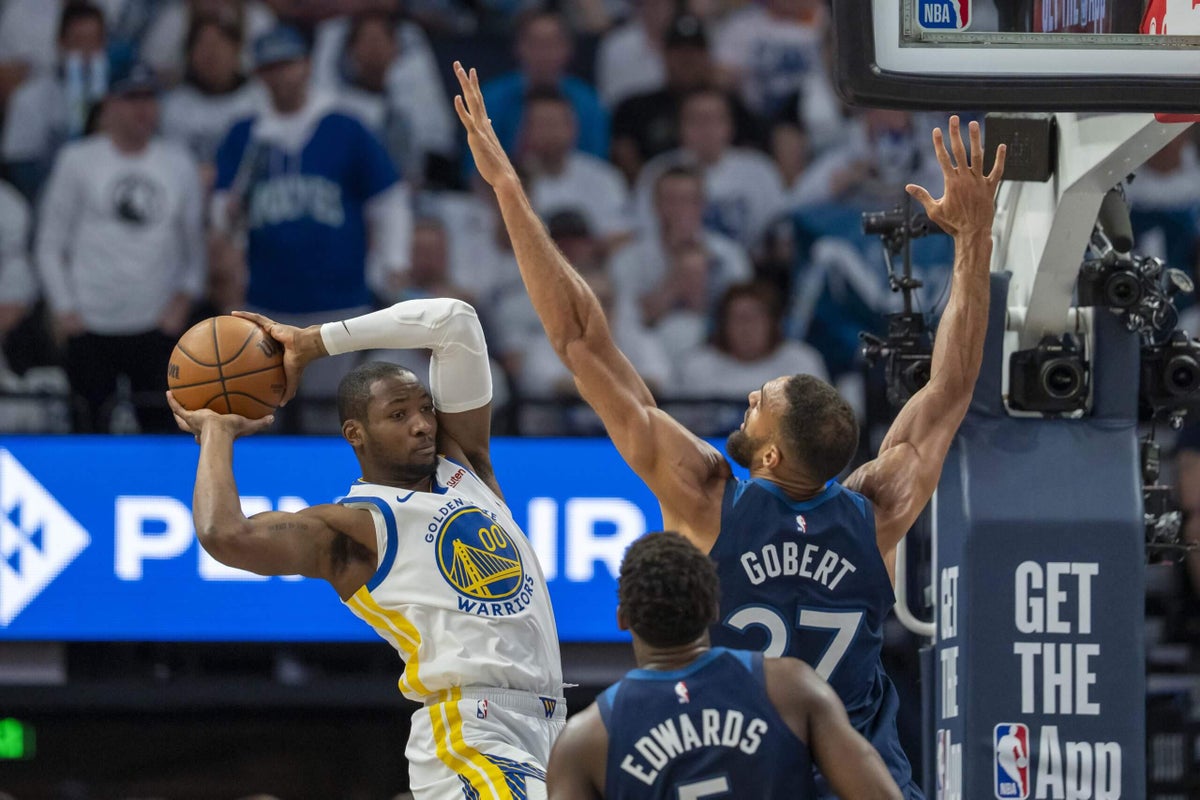

MINNEAPOLIS — In the aftermath of a Game 1 survival, Golden State Warriors coach Steve Kerr was delivered the MRI news he already feared. Steph Curry’s strained hamstring would sideline him for several games and force Kerr to completely readjust his strategy against a long, active Minnesota Timberwolves defense that no longer had Curry to obsess over and contain.
Advertisement
The 1-0 series lead gave Kerr enough breathing room for experimentation. After he met with his staff at the team hotel Wednesday afternoon, they came up with a tentative strategy: try everything, find something and don’t overtax the stars.
The result was a 117-93 response win from the Timberwolves, with three statistics that tell the cautious tale. Jimmy Butler played 34 minutes. Draymond Green played 29 minutes. The Warriors became the first team in playoff history to put 14 different players on the floor in the first half of a playoff game.
“I didn’t want to push it with Draymond or Jimmy,” Kerr said. “I didn’t want to chase this game unless it was really gettable. We obviously made a push in the second half. But we went into the game thinking we’d play a lot of people short-burst minutes, try to protect Jimmy and Draymond. They’ve been playing huge minutes every other day, flying all over the country. We had to weigh that.”
Kerr delivered this news to the team at shootaround. It’s a plausible reason why Butler didn’t ramp up the scoring aggression, taking only 13 shots. If Butler, still feeling the impact of his hard fall in Houston, only has one or two 45-minute full-throttle bullets in his chamber, the Warriors clearly didn’t want him to waste them in Game 2.
Kerr instead went about finding the correct combinations to put around Butler — the new focal point of Minnesota’s defensive scheme — and seemed to get some credible information about who should and shouldn’t have a rotation role in this series.
They started Quinten Post, but the struggling rookie center was yanked quickly. The Warriors were down 13-0 when he was subbed out of the game, and he wasn’t seen again, logging only three minutes. Moses Moody entered for him, and his slump continued. Moody has missed 14 straight shots dating back to Game 7 in Houston and appears likeliest (along with Post) to fall out of the immediate picture.
Advertisement
Trayce Jackson-Davis was the unlikely bench piece to surge onto the scene. He was the 13th Warriors player to enter the game and he had an offensive rebound and putback within 90 seconds of his arrival.
Jackson-Davis struggled to finish for the first few months of his second season, falling out of the rotation after Post emerged. But he looked like a more assertive rim-running force in his Game 2 first-half stint, dunking in traffic, reaching back for a difficult alley-oop and muscling in layups through contact like the rookie version who broke out.
Jackson-Davis finished with 15 points and six rebounds in his 19 minutes. He made all six of his shots, earned another look in the second half and already had Kerr announce postgame that he’d get Game 3 opportunities. He ran some high-screen action with Butler that is sure to be a part of the game plan.
“The domino effect of Steph being out led to Trayce playing tonight,” Kerr said. “Because we need the scoring. We need the finishing. You saw what he did out there. We had found a formula over the last couple of months and obviously we’re having a lot of success, but without Steph the formula completely goes out the window, and we’ve got to figure out the next one.”
Jonathan Kuminga will clearly be a major part of the new formula. The Warriors only had five points in the game’s first eight minutes when Kuminga — the eighth Warrior to enter — backed Anthony Edwards down deep into the paint and rose for this pretty jumper over him. He was the first Warriors player besides Butler to make a shot.
Kuminga made a couple defensive errors and committed a bad turnover, but he entered again for a second first-half stint and received a longer runway from Kerr. Without Curry, the Warriors were desperate for Kuminga’s ability to score in isolation and, given more freedom, he finally caught a rhythm. Kuminga made three straight shots to close the half and was 7 of 7 at one point in the second half.
“I feel like the confidence just came back,” Kuminga said.
Jonathan Kuminga: “I feel like the confidence just came back.” pic.twitter.com/L8vp1t0Vug
— Anthony Slater (@anthonyVslater) May 9, 2025
Kerr moved away from Kuminga in recent weeks because he said the two-man lineup numbers with him and Butler on the floor weren’t palatable. They were a minus-20 together in 125 regular-season minutes.
But that’s a pretty tiny sample, a rusty Kuminga was still returning from a 31-game absence and that was a world before the Curry injury when Kuminga was in a supplementary role that isn’t best fit for his game (or long-term career desires). Against this specific Minnesota team, facing a wave of length without much pure scoring talent dotting the roster, Kuminga is about to be featured offensively. Kerr started him in the second half next to Butler.
Advertisement
“I can play with anybody,” Butler said. “He can play with anybody. It’s all about playing basketball the right way. That’s all it is. Attack to score. Attack to pass. Just make the right play over and over again. Just play basketball the right way. Me and JK could thrive, can and will thrive together on the basketball floor.”
(Photo of Jonathan Kuminga being defended by Rudy Gobert and Anthony Edwards: Jesse Johnson / Imagn Images)
This news was originally published on this post .










Be the first to leave a comment